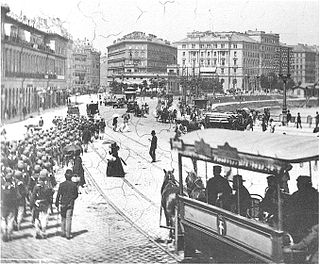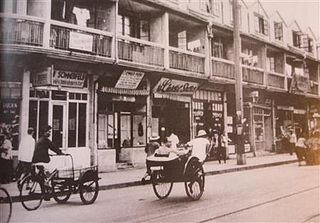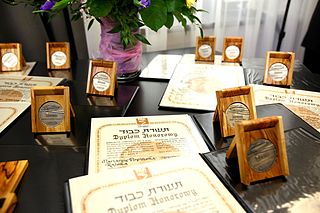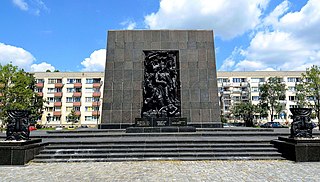
Righteous Among the Nations is an honorific used by the State of Israel to describe non-Jews who risked their lives during the Holocaust to save Jews from extermination by the Nazis for altruistic reasons. The term originates with the concept of "righteous gentiles", a term used in rabbinic Judaism to refer to non-Jews, called ger toshav, who abide by the Seven Laws of Noah.

Hotel Metropole was a hotel in Vienna, Austria that was constructed in 1871–73. It was destroyed during World War II after serving as the Vienna headquarters of the Gestapo from 1938. The address was Morzinplatz, in the I. District Innere Stadt.

Podgórze is a district of Kraków, Poland, situated on the right (southern) bank of the Vistula River, at the foot of Lasota Hill. The district was subdivided in 1990 into six new districts, see present-day districts of Kraków for more details. The name Podgórze roughly translates as the base of a hill. Initially a small settlement, in the years following the First Partition of Poland the town's development was promoted by the Austria-Hungary Emperor Joseph II who in 1784 granted it the city status, as the Royal Free City of Podgórze. In the following years it was a self-governing administrative unit. After the Third Partition of Poland in 1795 and the takeover of the entire city by the Empire, Podgórze lost its political role of an independent suburb across the river from the Old Town.

Daniel "Dani" Karavan was an Israeli sculptor best known for site specific memorials and monuments which merge into the environment.

Simcha Rotem was a Polish-Israeli veteran who was a member of the Jewish underground in Warsaw and served as the head courier of the Jewish Fighting Organization (ŻOB), which planned and executed the Warsaw Ghetto Uprising against the Nazis. He was one of the last two surviving Jewish fighters in the Warsaw uprising and the last surviving fighter from the 1943 Warsaw Ghetto Uprising.

The Shanghai Ghetto, formally known as the Restricted Sector for Stateless Refugees, was an area of approximately one square mile in the Hongkew district of Japanese-occupied Shanghai. The area included the community around the Ohel Moshe Synagogue. Shanghai was notable for a long period as the only place in the world that unconditionally offered refuge for Jews escaping from the Nazis. After the Japanese occupied all of Shanghai in 1941, the Japanese army forced about 23,000 of the city's Jewish refugees to be restricted or relocated to the Shanghai Ghetto from 1941 to 1945 by the Proclamation Concerning Restriction of Residence and Business of Stateless Refugees. It was one of the poorest and most crowded areas of the city. Local Jewish families and American Jewish charities aided them with shelter, food, and clothing. The Japanese authorities increasingly stepped up restrictions, surrounded the ghetto with barbed wire, and the local Chinese residents, whose living conditions were often as bad, did not leave. By 21 August 1941, the Japanese government closed Shanghai to Jewish immigration.

Henryk Iwański (1902-1978), nom de guerre Bystry, was a member of the Polish resistance during World War II. He is known for leading one of the most daring actions of the Armia Krajowa in support of the Warsaw Ghetto Uprising, however later research cast doubts on the veracity of his claims. For his assistance to the Polish Jews Iwański was bestowed the title of the Righteous Among the Nations by Yad Vashem in Jerusalem in 1964.

Jan Żabiński and his wife Antonina Żabińska (1908–1971) were a Polish couple from Warsaw, recognized by Yad Vashem as Righteous Among the Nations for their heroic rescue of Jews during the Holocaust in Poland. Jan Żabiński was a zoologist and zootechnician by profession, a scientist, and organizer and director of the renowned Warsaw Zoo before and during World War II. He became director of the Zoo before the outbreak of war but during the occupation of Poland also held a prestigious function of the Superintendent of the city's public parks in 1939–1945. A street in Warsaw is named after him.

Anton Schmid was an Austrian recruit in the Wehrmacht who saved Jews during the Holocaust in Lithuania. A devout but apolitical Roman Catholic and an electrician by profession, Schmid was conscripted into the Austro-Hungarian Army during World War I and later into the Wehrmacht during World War II.

Josef Weinheber was an Austrian lyric poet, narrative writer and essayist.

In early modern era, European Jews were confined to ghettos and placed under strict regulations as well as restrictions in many European cities. The character of ghettos fluctuated over the centuries. In some cases, they comprised a Jewish quarter, the area of a city traditionally inhabited by Jews. In many instances, ghettos were places of terrible poverty and during periods of population growth, ghettos had narrow streets and small, crowded houses. Residents had their own justice system. Around the ghetto stood walls that, during pogroms, were closed from inside to protect the community, but from the outside during Christmas, Pesach, and Easter Week to prevent the Jews from leaving at those times.

The citizens of Poland have the world's highest count of individuals who have been recognized by Yad Vashem of Jerusalem as the Polish Righteous Among the Nations, for saving Jews from extermination during the Holocaust in World War II. There are 7,177 Polish men and women recognized as Righteous Among the Nations, over a quarter of the 27,921 recognized by Yad Vashem in total. The list of Righteous is not comprehensive and it is estimated that hundreds of thousands of Poles concealed and aided hundreds of thousands of their Polish-Jewish neighbors. Many of these initiatives were carried out by individuals, but there also existed organized networks of Polish resistance which were dedicated to aiding Jews – most notably, the Żegota organization.

Irena Adamowicz, was a Polish-born scout leader and a resistance member during World War II. She was a courier for the underground Home Army. In 1985, Adamowicz was posthumously bestowed the title of the Righteous Among the Nations by Yad Vashem in Jerusalem for her activities involving providing information to a number of Jewish ghettos in occupied Poland.

The Będzin Ghetto was a World War II ghetto set up by Nazi Germany for the Polish Jews in the town of Będzin in occupied south-western Poland. The formation of the 'Jewish Quarter' was pronounced by the German authorities in July 1940. Over 20,000 local Jews from Będzin, along with additional 10,000 Jews expelled from neighbouring communities, were forced to subsist there until the end of the Ghetto history during the Holocaust. Most of the able-bodied poor were forced to work in German military factories before being transported aboard Holocaust trains to the nearby concentration camp at Auschwitz where they were exterminated. The last major deportation of the ghetto inmates by the German SS – men, women and children – between 1 and 3 August 1943 was marked by the ghetto uprising by members of the Jewish Combat Organization.

The Grodno Ghetto was a Nazi ghetto established in November 1941 by Nazi Germany in the city of Grodno for the purpose of persecution and exploitation of Jews in Western Belarus.

The Monument to the Ghetto Heroes is a monument in Warsaw, Poland, commemorating the Warsaw Ghetto Uprising of 1943 during the Second World War. It is located in the area which was formerly a part of the Warsaw Ghetto, at the spot where the first armed clash of the uprising took place.

Sigmund A. Rolat or Zygmunt Rolat is a philanthropist, art collector and businessman. He is a founding donor of Polin, The Museum of the History of Polish Jews and a key supporter of numerous charitable endeavors.

The Kielce Ghetto was a Jewish World War II ghetto created in 1941 by the Schutzstaffel (SS) in the Polish city of Kielce in the south-western region of the Second Polish Republic, occupied by German forces from 4 September 1939. Before the Nazi invasion of Poland in 1939, Kielce was the capital of the Kielce Voivodeship. The Germans incorporated the city into Distrikt Radom of the semi-colonial General Government territory. The liquidation of the ghetto took place in August 1942, with over 21,000 victims deported to their deaths at the Treblinka extermination camp, and several thousands more shot, face-to-face.
The American Memorial to Six Million Jews of Europe, also referred to as the Warsaw Ghetto Memorial, is a public Holocaust memorial situated at Warsaw Ghetto Memorial Plaza in Riverside Park, within the Upper West Side of Manhattan, New York City. It is a monument to the Warsaw Ghetto Uprising and the six million Jews who were murdered in the Holocaust. Dedicated on October 19, 1947, it is one of the first memorials to the Holocaust in the United States.


















